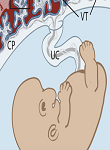|
|
|
Mechanisms Safeguarding the Trophoblast Multipotent State
|
|
|
|
|
|
|
|
|
|

|
|
|
|
Stephanie Chrysanthou, and Myriam Hemberger
|
|
|
|
University of Cambridge
|
|
Epigenetics Programme, Babraham Institute/Centre for Trophoblast Research, University of Cambridge, CB2 1TN, UK
|
|
stephanie.chrysanthou@einstein.yu.edu
|
|
|
|
|
|
|
|
|
|

|
|
The placenta is a highly specialized organ that is indispensable for intrauterine development to occur. Trophoblast cells are the major constituents of the developing placenta. They are the first cell type to arise very early in development, making up the trophectoderm, the outer layer of the blastocyst, segregating from the inner cell mass which gives rise to the embryo itself. The various functions of trophoblast cells early in development are vital for reproductive success, as they lay the foundations for a normal pregnancy and a healthy fetus. A better understanding of the mechanisms underlying these early events, including how the early trophoblast niche is regulated by transcription factors and specific epigenetic modifiers, is critical for understanding and eventually treating placental pathologies, which can inevitably cause pregnancy complications.
|
|
|
|
|
|
|
|

|
|